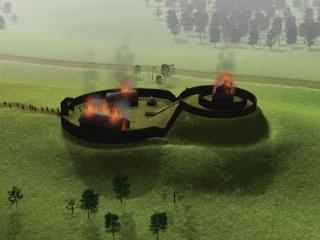| |

|
| |

|
The castle seems to have remained in royal hands throughout the reigns of Henry II and Richard I. Robert Roos was
confirmed as the owner in 1200 but he joined with the northern barons against King John and his castle was burnt to
the ground in 1216 in retaliation.
From this page you can go to the following:
|
|
|
Wark Castle: Wark Castle in 12th and 13th Centuries
Wark suffered greatly at the hands of the Scottish kings during the 12th and 13th centuries. It was captured by King
David on two occasions: in 1126, when he invaded Northumberland in support of his niece Matilda's claim to the
English throne; and in 1138 when he invaded England again in an attempt to win the earldom of Northumberland.
A three week siege in January 1138 failed to reduce the garrison and the siege was abandoned. Another attempt was
made at Easter, the surrounding countryside was ravaged to prevent supplies reaching the defenders but again this
proved unsuccessful. In the third attempt, siege engines were used unsuccessfully, but the garrison was eventually starved out.
Most of the horses in the castle had been killed and eaten when instructions arrived from
Walter Espec to surrender; the garrison had behaved so bravely that David allowed them to march out with honours and
gave them a gift of 24 horses. The castle, however, was destroyed.
Walter Espec, the original owner of the castle, died in 1153 and the castle may have passed to the Crown for a while. Accounts from 1174 mention 10
knights and 40 squires garrisoning the Castle and make it clear that provisions were being supplied in order to
withstand a siege. That siege came later in the year when the Scottish King, William the Lion, attacked using
Flemish mercenaries. The attacking forces managed to get across the moat but were driven back. Siege engines were
equally unsuccessful and the attack was abandoned.
|
|